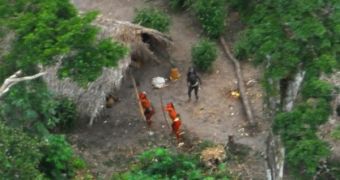Last week a team of anthropologists and uncontacted tribe experts revealed a series of images showing what is considered to be one of the one hundred or so uncontacted tribes currently living around the world. The pictures were taken during a flight over the tropical jungle located near the border between Brazil and Peru. There are allegedly more than 50 tribes living in this area of the globe, which are now in danger of coming in contact either with other tribes or with the modern civilization logging the tropical Amazonian forest.
Experts believe that the pictures released on Thursday may show a population remnant of a much bigger tribe that separated as its members were forced deeper into the forest, and rather than being lost they might have had in fact a close contact with other groups of indigenous people living in the surrounding areas.
"I think there is an ethical question whether you can in the end keep them from any contact and I think the answer to that is no. The right answer is to have the kind of contact and change that the tribes themselves manage the pace of it", said Thomas Lovejoy, president of The Heinz Center and an Amazon expert.
Such groups are continuously pushed towards the Brazilian territory where they are most likely to enter in conflict with other indigenous groups, which unlike the Peruvian one are protected and recognized by the Brazilian government. "While we are getting arrows in the face, it's fine. The day that they are well-behaved, they are finished", said Jose Carlos Meirelles, a Brazilian Indian protection official who was present in the aircraft the pictures were taken from.
Historically, the contact of the European colonists with similar tribes and Brazilian Indians had a disastrous effect on their population, which now numbers about 350,000 individuals. It is estimated that the original population was about 5 million before the American continent was colonized.
"In 508 years of history, out of the thousands of tribes that exist none have adapted well to society in Brazil", said Sydney Possuelo, a former Brazilian Indian protection official. Nonetheless, the Brazilian government offers great protection for the tribes on their territory, such as the Yanomami, which have been politically recognized and are in contact with foreign conservationists.
"It's not about making that decision for them. It's about making time and space to make that decision themselves", said David Hill of the Survival International group.
In Peru, on the other hand, progress in this direction appears to be somehow slower, leaving room for disasters such as the one in 1996 when half of the population of the Murunahua tribe died of common cold or other illnesses.
Since Peru has no Indian Affairs department such as the one in Brazil to forbid contact with unknown tribes, the estimated 50 groups currently living at the border of the two countries are at risk of falling victims to excessive logging and oil and gas exploration companies.
"There is a lot of logging going on over on the Peruvian side. It's had all kinds of effects on the groups living there, particularly on the uncontacted groups - it's led to violent conflicts and deaths", Hill added.

 14 DAY TRIAL //
14 DAY TRIAL //